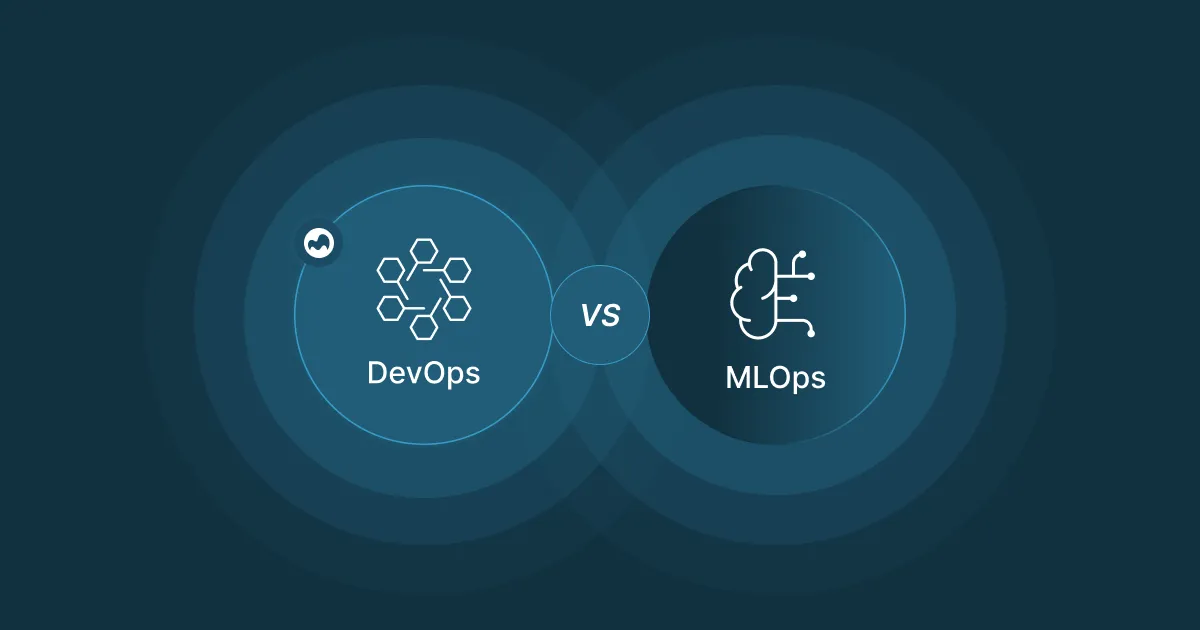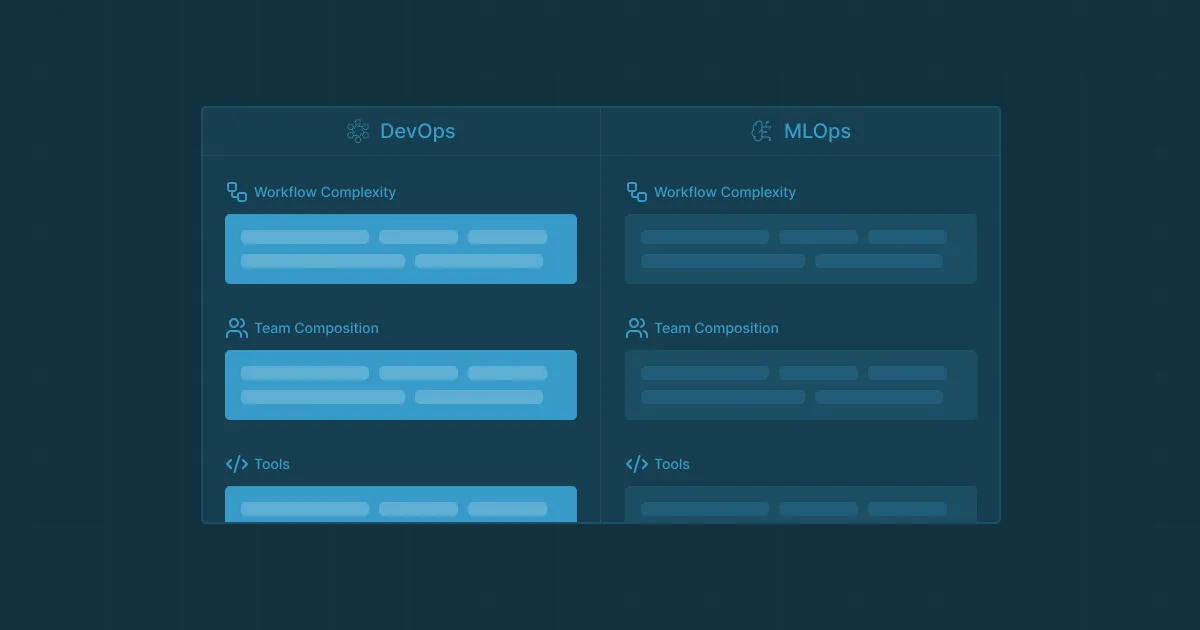MLOps vs DevOps: Why DevOps with Microtica Leads the Way

With the introduction of artificial intelligence in the market, organisations are always on the lookout for ways to speed up software delivery and improve operational efficiency. Two terms that often come up in this context are MLOps and DevOps.
They do share similarities, but their focus and execution differ significantly. DevOps was used to deal with software development challenges, while MLOps builds upon these principles. However, machine learning (ML) addresses unique challenges like massive datasets, data drift and concept drift.
This article explores the differences between MLOps and DevOps. We'll discuss why DevOps, especially when powered by platforms like Microtica, remains the more favourable approach for most businesses.
Understanding DevOps and MLOps
Before we go further into the MLOps vs DevOps battle, it's best first to learn more about each of them. This way, we can better understand which one is best suited for our business.
DevOps Explained
DevOps is a set of practices that combines software development (Dev) and IT operations (Ops). Its goal is to shorten the development lifecycle while delivering features, fixes and updates frequently in close alignment with business objectives. Breaking down the traditional barriers between operations and development teams, this approach allows for quicker and more dependable software releases.
The following combination of DevOps’s core components and objectives makes it a powerful methodology for modern software development:
- Infrastructure as Code (IaC)
- CI/CD pipelines
- Monitoring and observability
- Enhanced teamwork
- Accelerated development cycles
- Operational effectiveness
The philosophy behind DevOps emphasises building a collaborative culture while automating repetitive tasks to boost efficiency and speed up the rollout of new features. Today, major organisations such as Meta and Amazon rely on DevOps practices to deploy software updates on a daily basis.
MLOps Explained
MLOps (Machine Learning Operations) is an extension of DevOps, sharing the aim of automating workflows, but tailored specifically for machine learning projects. It addresses the unique challenges of deploying, monitoring and maintaining machine learning models in production. MLOps integrates data science, model training and deployment workflows to ensure that models remain accurate and reliable over time.
The primary objectives of MLOps include:
- Cross-team collaboration
- Scalability
- Reproducibility and reliability
- Automation across the ML Lifecycle
- Addressing ML-specific challenges
MLOps vs DevOps Key Differences
MLOps introduces complexities that do not exist in traditional DevOps, such as managing datasets, retraining models and detecting model drift. However, these complexities also mean that MLOps requires specialised tools and expertise, which can increase costs and slow down delivery.
Below is a brief overview of the MLOps vs DevOps key differences:
Similarities Between MLOps and DevOps
Despite their distinct focuses, MLOps vs DevOps share many fundamental principles and practices. MLOps essentially builds upon the DevOps foundation to address the specific needs of machine learning workflows. Both disciplines strive to improve efficiency, collaboration and reliability through automation and continuous improvement.
One of the main shared elements is the use of continuous integration and continuous delivery (CI/CD) pipelines. Both disciplines automate the building, testing and deployment of code to reduce manual effort and accelerate releases. MLOps extends these pipelines to include steps like data validation and model training. Still, the underlying goal remains to ensure smooth transitions from development to production environments.
Both MLOps and DevOps rely heavily on Infrastructure as Code (IaC) to provision and manage environments. Although MLOps often requires specialised infrastructure for training and serving models, the underlying IaC approach is shared.
Monitoring and feedback loops are emphasised by both options to maintain the system's health and performance. They ensure models and applications work as intended. Another one of the goals is to make sure that the issues are identified and resolved quickly.
Collaboration is also on the list of overlaps. DevOps brings together development and operations teams, while MLOps expands this collaboration to include data scientists and ML engineers. Both encourage breaking down silos to foster communication, shared responsibility and faster iteration.
And finally, both practices emphasise automation and continuous improvement. Teams can reduce errors, accelerate delivery and adapt quickly to changing requirements because they automate repetitive tasks and integrate feedback loops.
Why DevOps Remains the Center of Modern Software Delivery
While MLOps is gaining traction in AI-driven organisations, DevOps continues to be the foundation for most software development and deployment efforts. Here’s why:
- Mature Ecosystem: DevOps has a rich ecosystem of tools and platforms that simplify automation, monitoring and collaboration. Companies turn to Microtica because it provides an integrated environment that reduces tool sprawl and complexity.
- Faster Time to Market: DevOps practices enable teams to ship features quickly and reliably. This is somewhat different from MLOps. With its additional layers of complexity, it often requires longer cycles to ensure model quality.
- Broader Applicability: DevOps principles apply to nearly all software projects, including web applications, mobile apps and backend services. On the other hand, MLOps is a niche, focused on machine learning workflows.
- Cost Efficiency: Cost may sometimes be a decisive factor. This is why DevOps platforms are a popular choice because they streamline workflows and reduce manual overhead. MLOps, on the other hand, demands specialised skills and infrastructure, which can increase operational costs, where the main goal is to cut down costs.

How Microtica Enhances DevOps Compared to MLOps Challenges
Throughout this MLOps vs DevOps discussion, we've already learned that MLOps requires managing code, data, models and continuous retraining. This adds layers of complexity that can slow down delivery and increase costs. Contrary to this, Microtica’s DevOps platform focuses on streamlining the entire software lifecycle with automation and best practices. This makes it easier to:
- Improve collaboration where centralised dashboards and monitoring tools enhance visibility and communication among developers and operations.
- Standardise the infrastructure, which is why Microtica offers reusable infrastructure components, promoting consistency across teams and projects.
- Scale efficiently, where Microtica's cloud-native architecture helps to support scaling without added complexity. This is a crucial advantage over the often fragmented MLOps toolchain.
- Use the built-in CI/CD pipelines to automate testing and deployment, as well as accelerate delivery to reduce manual errors and delays.
When To Choose MLOps Over DevOps
The debate of MLOps vs DevOps often comes down to the specific needs of an organisation. While MLOps addresses the unique challenges of machine learning, it also introduces complexity and cost that may not suit every team.
DevOps, especially when supported by a comprehensive platform like Microtica, offers a proven, scalable, and cost-effective approach to software delivery. Its automation, standardisation, and developer-friendly features make it the pillar of modern cloud-native development. For the majority of software projects, traditional DevOps remains the most practical and cost-effective approach.
For companies aiming to accelerate innovation, reduce overhead, and maintain control over their infrastructure, embracing DevOps with Microtica is a smart choice. It empowers teams to deliver software faster, with fewer errors, collaborate better and scale confidently, all without the complexity that MLOps workflows often entail.
Subscribe to receive the latest blog posts to your inbox every week.
*By subscribing you agree to with our Privacy Policy.

Relevant Posts



